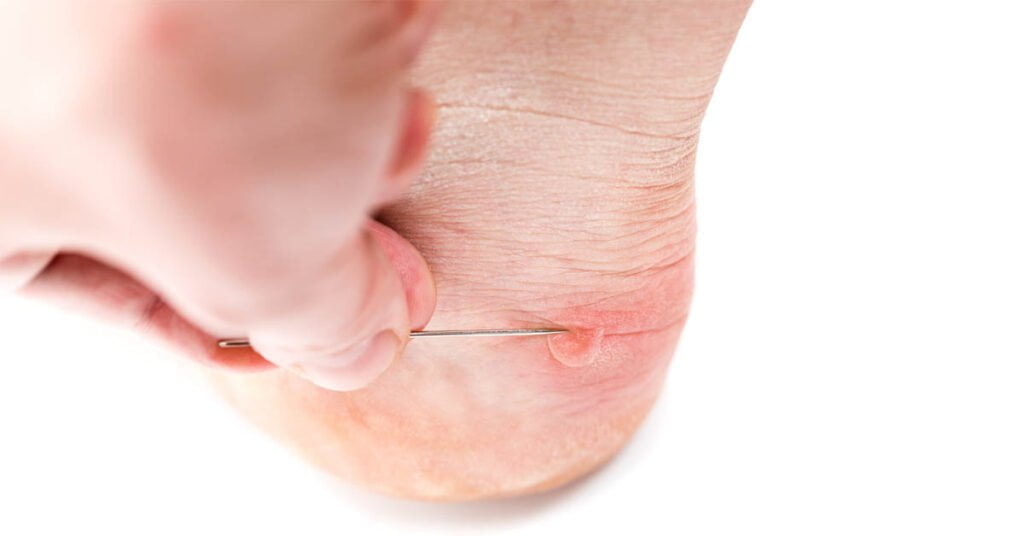What is a foot blister?
A foot blister is caused by friction and pressure on the skin. This can happen if your shoes don’t fit properly or if you walk a lot. Foot blisters can be very painful and difficult to prevent. Fortunately, there are some things you can do to reduce the likelihood of blisters.
Treating beginning blister
If a blister is beginning, you can temporarily shield the damaged skin or blister with a blister plaster. If the blister is already advanced, you can clean it and the surrounding area with running water or disinfectant.
Treating an existing foot blister
If you have sustained one or more blisters, it is important to take proper care of them.
Pierce blister?
Preferably not, try to keep a blister intact for as long as possible. A blister is a natural protective mechanism which helps prevent infection. So preferably keep a blister closed for faster blister healing time
Pierce painful blister anyway
If a blister is painful and causing swelling, it may still be necessary to puncture it in some cases. then proceed as follows:
- Work hygienically and safely.
- Clean the blister and surrounding area with running water or disinfectant.
- Use a sterile blister pricker (blood lancet) or a needle (from the sewing kit) disinfected with disinfecting alcohol.
- Pierce the skin in two places at the base of the blister.
- Using a gauze pad, gently squeeze the blister.
- Make sure the used needle or blister stick is safely stored away or discarded.
Cover the blister with a wound plaster or sterile non-adherent pad and secure the pad with an adhesive or fixation plaster.

Is the blister open? Then clean the wound and cover it with sterile bandages or a plaster. Make sure the bandage is wide over the blister, there are no folds in it and it cannot slide. After a day, the dressing can be replaced.
Treating an open foot blister
Is the blister torn open? Then clean it and use sterile scissors so you can cut away the loosened skin. Then clean the wound thoroughly and cover it with sterile bandages or a protective wound plaster.
Make sure that the bandage sits generously over the blister and cannot shift as this can cause unsightly wounding. Change the dressing daily to prevent infection
Preventing foot blisters? Here’s what you need to know!
Feel a blister coming on. If so, try to tape these as soon as possible with a blister plaster and, if possible, wear different footwear.
Preventing foot blisters often starts with wearing shoes that offer the right size and support. Choose shoes with a good fit that cover your foot and do not pinch or drag.
Avoid thin socks or other materials that cause pressure or friction – rather choose thicker fabrics such as cotton or wool.
Make sure feet are dry. Wet feet skin is fragile and prone to blisters. So if you suffer from sweaty feet use an anti-perspirant such as PediSpray®
An old and well-known remedy is Camphor Spirit. Camphor spirit makes the skin on your feet a little harder, making it more resilient and less likely to develop blisters.
PediSpray® contains camphor which helps to firm the skin. Yet another reason to use this remedy preventively
Keep your shoes dry by airing them well after each use. If you do get foot blisters, make sure to clean them regularly to prevent infection.
If you suffer from pain, try applying a band-aid to reduce irritation. And if you walk or stand a lot, take regular rest breaks to help relieve the pressure on your feet!
Shoes too tight and suffering from blisters? Perhaps this trick will help
Put on your new shoes with your thickest pair of socks and warm the pinching areas with a hair dryer. These spots cause friction, which can cause blisters. Keep the shoes on until they have cooled completely.
Heat causes the material to expand in the tight spots, so your new shoes suddenly fit like a glove.
